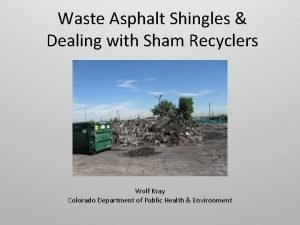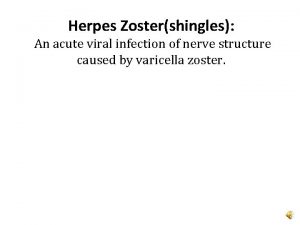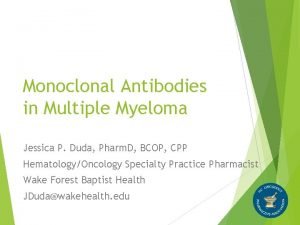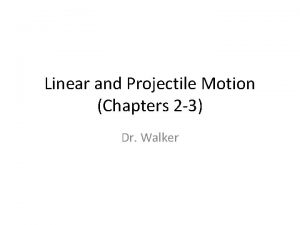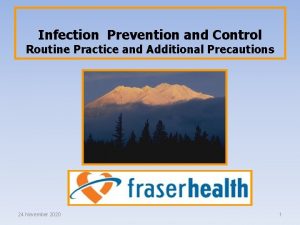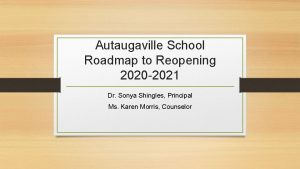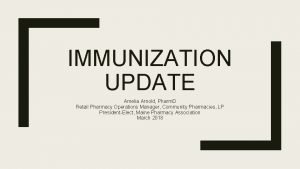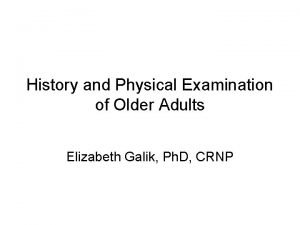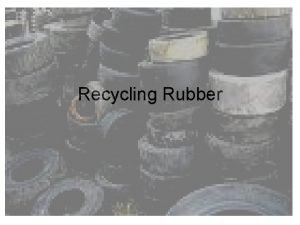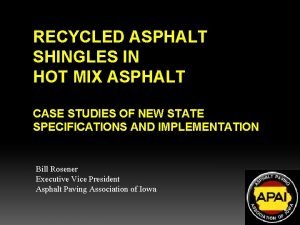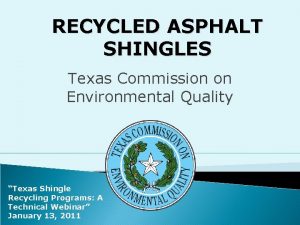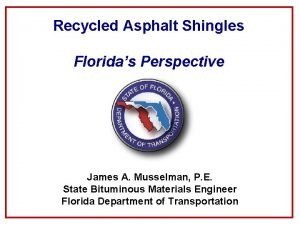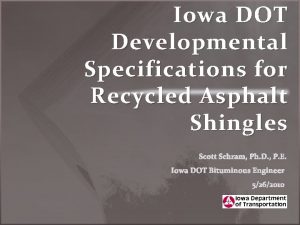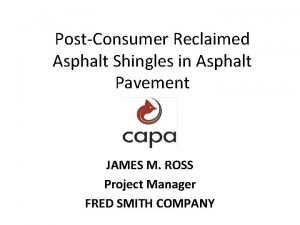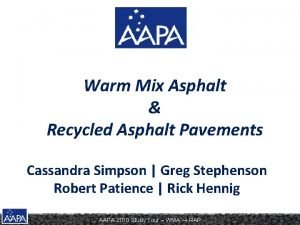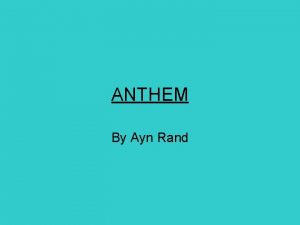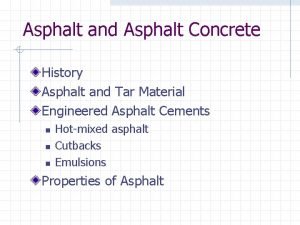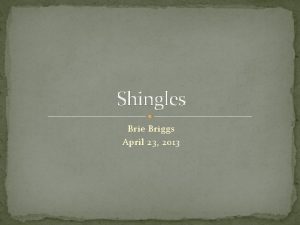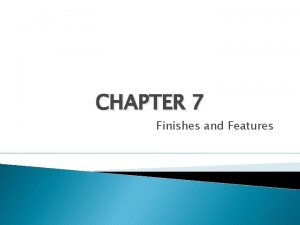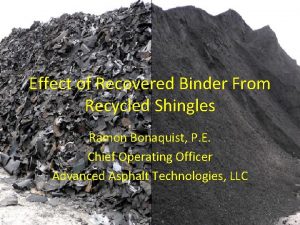Recycled Asphalt Shingles in Texas Dale Rand P













- Slides: 13

Recycled Asphalt Shingles in Texas Dale Rand, P. E.

Why Recycled Shingles? • A good source for asphalt • Reduces landfill consumption • Conserves natural resources

Typical Shingle Composition Granular/aggregate Waterproofing asphalt Base (fiberglass or organic felt) Waterproofing asphalt Back surfacing Component Organic Felt Fiberglass Mat Asphalt cement 30 -36% 19 -22% Felt (Fiber) 2 -15% Mineral aggregate (#30) 20 -38% Mineral filler/stabilizer 8 -40%

Initial Research SH 31, Navarro County • May, 1997 • Type C with AC-20 – Section 1 – 5% man. waste – Section 2 – 5% tear-offs – Section 3 - Control • Initial construction issues with tear-offs section • Overall performance good - comparable to control

• Allow Manufactured Waste – Memo - March, 2006 – Treated the same as RAP – counter flow drum – Up to 15% • Added residential tear-off shingles – Memo – Feb. , 2009 – Asbestos certification and testing – Deleterious material < 1. 5% – No direct flame for shingle material

• Special Provision to Item 341 -024 • Allows manufactured waste and residential “tear-offs” – up to 5% – deleterious limited to 1. 5% – 100% passing 1/2“ sieve, 95% passing 3/8” sieve • RAS can be combined with – RAP – WMA – Substitute Binders (lower binder grade)

New Specification RAS. Use of post-manufactured RAS or post-consumer RAS is permitted unless otherwise shown on the plans. RAS are defined as processed asphalt shingle material from manufacturing of asphalt roofing shingles or from re-roofing residential structures. Post-manufactured RAS are processed manufacturer’s shingle scrap by-product. Postconsumer RAS, or tear-offs, are processed shingle scrap removed from residential structures. Comply with all regulatory requirements stipulated for RAS by the Texas Commission on Environmental Quality (TCEQ). RAS may be used separately or in conjunction with RAP. Process the RAS by ambient grinding or granulating such that 100% of the particles pass the 1/2 in. sieve and 95% pass the 3/8 in. sieve when tested in accordance with Tex-200 -F, Part I. Perform a sieve analysis on processed RAS material prior to extraction (or ignition) of the asphalt. Add sand meeting the requirements of Table 1 and Table 2 or fine RAP to RAS stockpiles if needed to keep the processed material workable. When RAS is preblended with sand or fine RAP, show the materials as two separate bins on the mixture design job mix formula (JMF) even though the combined materials are added using a single cold feed bin.

New Specification (continued) Determine asphalt content and gradation of the RAS material for mixture design purposes in accordance with Tex-236 -F. Do not exceed the maximum allowable percentages of RAS shown in Table 5. Asphalt binder from RAS and RAP is designated as recycled asphalt binder. When RAS or RAP is used, calculate and ensure that the ratio of the recycled asphalt binder to total binder does not exceed the percentages shown in Table 5. The allowable percentages shown in Table 5 may be decreased or increased when shown on the plans. Certify compliance of the RAS with DMS-11000, “Evaluating and Using Nonhazardous Recyclable Materials (NRM) Guidelines. ” If the RAS has not come into contact with any hazardous materials, treat it as an established NRM. Unless otherwise directed, use only RAS from shingle sources on the Construction Division’s “Nonhazardous Recycled Materials” approved list at http: //www. dot. state. tx. us/txdot_library/publications/producer_list. htm. Prior to use, remove substantially all materials that are not part of the shingle, such as wood, paper, metal, plastic, and felt paper. Determine the deleterious content of RAS material for mixture design purposes in accordance with Tex-217 -F, Part III. Unless otherwise approved, do not use RAS if deleterious materials are more than 1. 5% of the stockpiled RAS. Submit a sample for approval to the Engineer prior to submitting the mixture design. The Department will perform the testing for deleterious material of RAS to determine specification compliance.

New Specification Table 1 A Maximum Allowable Amounts of Recycled Binder, RAP & RAS Maximum Allowable % (Percentage by Weight of Total Mixture) Maximum Ratio of Recycled Binder 1 to Total Binder (%) Unfractionated RAP 2 Fractionated RAP 3 RAS 4 Surface Mixes 5 35 10 20 5 Non-Surface Mixes 6 < 8 in. From Final Riding Surface 40 15 30 5 Non-Surface Mixes 6 > 8 in. From Final Riding Surface 45 20 40 5 Mixture Description & Location

Worksheet

Approved List • Have met regulatory and specification requirements • Have a quality control plan for asbestos testing plan in place • Keep records of materials processed for chain of custody purposes

Plants & Processors Shingle Manufacturer Capability to process asphalt shingles

Questions?
 Recycled asphalt colorado springs
Recycled asphalt colorado springs Dale rand
Dale rand Vagus nerve shingles
Vagus nerve shingles Elotuzumab nejm
Elotuzumab nejm Shingles vaccine side effects
Shingles vaccine side effects Luke autbeloe drops a pile of roof shingles
Luke autbeloe drops a pile of roof shingles Luke drops a pile of roof shingles
Luke drops a pile of roof shingles Shingles precautions
Shingles precautions Sonya shingles
Sonya shingles Shingles medscape
Shingles medscape Shingles older adults
Shingles older adults Otto emissions is driving his car at 25.0 m s
Otto emissions is driving his car at 25.0 m s K-shingles examples
K-shingles examples Can rubber be recycled
Can rubber be recycled
